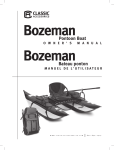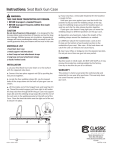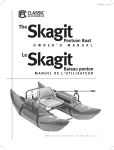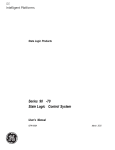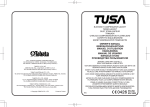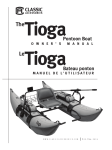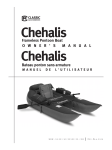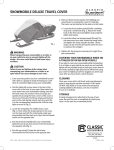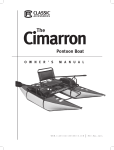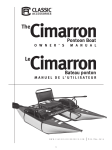Download Pontoon Boat - American RV Company
Transcript
Bozeman Pontoon Boat O W N E R ' S M A N U A L B OZ E M A N P O N T O O N B O AT O W N E R ’ S M A N U A L TABLE OF CONTENTS INTRODUCTION3 PRODUCT SPECIFICATIONS & CAPACITY 4 SAFETY INFORMATION AND SYMBOLS 5 RESPONSIBILITIES OF THE OPERATOR(S) 6 CERTIFICATE OF ORIGIN AND HIN NUMBERS 7 INFLATION & ASSEMBLY 8 PARTS LIST 9 ASSEMBLY AND USE 10-14 TROUBLESHOOTING 15 BLADDER REPAIR 16 CARE AND STORAGE 17 2 B OZ E M A N P O N T O O N B O AT O W N E R ’ S M A N U A L INTRODUCTION Congratulations on your purchase of a Classic Accessories pontoon boat. This manual has been compiled to help you assemble your boat correctly and operate it safely. It contains specific details of the boat, including its parts and equipment, and information on its safe operation, proper care, maintenance and repair. Please read it carefully, and familiarize yourself with your boat before using it. If this is your first pontoon boat, or if you are changing to this type of boat for the first time, for your own comfort and safety, please ensure that you obtain handling and operating experience before serious use. Doing so will assure many years of trouble free use and enjoyment. PLEASE KEEP THESE INSTRUCTIONS IN A SECURE PLACE, AND TRANSFER THEM TO THE NEW OWNER IF YOU SELL THE CRAFT. MODIFICATIONS Because of possible interference with the design and integrity of the boat, owner modifications to the boat, any of its parts, equipment or systems are not recommended and will void the warranty. Questions, problems, missing parts? Before returning to your retailer, call Classic Accessories customer service at 1-800-854-2315, 8 a.m. - 4 p.m., PST, Monday-Friday. Email: [email protected] 3 B OZ E M A N P O N T O O N B O AT O W N E R ’ S M A N U A L P R O D U C T S P EC I F I C AT I O N S & C A PA C I TY BOAT SPECIFICATIONS Product Name: BOZEMAN Pontoon Boat Dimensions: 96 inch L x 55 inch W x 29.5 inch H (top of the seat) 244 cm L x 140 cm W x 75 cm H (top of the seat) Dry Weight: 45 lbs (20 kg) (backpack and pontoon boat) Maximum Persons Capacity: 1 person up to 275 lbs (125 kg) Maximum Person & Gear Capacity: 350 lbs (159 kg) Recommended Inflation Pressure: 2.5 psi (0.17 BAR) BOAT CAPACITY The person/load capacity is partly dependent on proper seating and load distribution. Make sure that your load is distributed evenly and the seating position is such that, when afloat, the boat rides level in the water. WARNING - DO NOT EXCEED THE MAXIMUM CAPACITY OF THIS BOAT UNDER ANY CIRCUMSTANCES. WARNING - THIS BOAT IS NOT RATED FOR PROPULSION BY A MOTOR. U.S. COAST GUARD MAXIMUM CAPACITIES 1 PERSON OR 275 LBS. 350 LBS PERSONS, GEAR PRESSURE = 2.5 psi (main chambers) MANUFACTURER: CLASSIC ACCESSORIES, INC. KENT, WA, USA 98032 158 kg 0.17 bar (main chambers) 4 B OZ E M A N P O N T O O N B O AT O W N E R ’ S M A N U A L SA F E TY I N F O R M AT I O N A N D S Y M B O L S The symbol to the left is the Safety Alert symbol. It is used to alert you of potential personal injury hazards. Obey all safety messages that follow this symbol to avoid possible injury or death. DANGER Indicates a potentially hazardous situation which, if not avoided, will result in death or serious injury. WARNING Indicates a potentially hazardous situation which, if not avoided, could result in death or serious injury. CAUTION Indicates a potentially hazardous situation which, if not avoided, may result in minor or moderate injury. CAUTION Indicates a potentially hazardous situation which, if not avoided, may result in property damage. This manual lists certain recommended practices and provides some basic precautions. However, this list of precautions is not all-inclusive. Users must follow all applicable laws, rules, and regulations and should exercise appropriate caution in the safe operation of this pontoon boat. REMEMBER - always use common sense when using your pontoon boat. 5 B OZ E M A N P O N T O O N B O AT O W N E R ’ S M A N U A L RESPONSIBILITIES OF THE OPERATOR IMPORTANT SAFETY AND CARE INFORMATION SAFETY • Follow the inflation sequence listed in this instruction manual. • Recommended working pressure is 2.5 psi (0.17 bar). DO NOT EXCEED 2.5 PSI. • Check for leaks before using. • Remember that air pressure changes with temperature and elevation so always check your air pressure before use. • Partially deflate if leaving boat in direct sunlight or within a vehicle in sunlight. • Check all frame pins,screws and wing nuts before each use. • Read this owner’s manual carefully before using your pontoon boat. • This product is not to be used by children under 16 years of age or by any child without adult supervision. This pontoon boat is not a toy. Check the laws in your state. • Not for use by children or as pool toy. • This is not a life saving device. • You MUST always wear an approved Coast Guard personal flotation device (PFD). • All safety equipment & PFDs must properly fit the user, be in good condition and suitable for your body weight. • Know and follow all local water safety rules and boating regulations. • Do not exceed 350 lbs (159 kg) total cargo weight. (The weight of you and all of your gear should not exceed 350 lbs (159 kg). • Inspect your pontoon boat for wear or damage before and after each use. • Class 1 river rating: not for use in rough water, white water, rapids or open sea. • Never float alone. • Never use this boat in bad weather. • Keep sharp objects (knives, fish hooks, etc.) away from the pontoons. • Do not use under the influence of drugs or alcohol. • Do not tow this pontoon boat. • Use only in water free from debris and obstructions. • Do not use in high wind, rapid currents, open water or dangerous tides. • Seek shelter from water if there is threat of lightning. • Do not stand on this product while in use. • Never jump into or dive from this boat. • Inflate with cold air only. • Do not over inflate or use CO2 or a high pressure air compressor to inflate. 6.43 inch CARE • Clean with warm water and a mild detergent. • To avoid mildew be sure your boat is dry before storing it. • Deflate pontoons slightly between uses to extend the life of your boat. WARNING DO NOT stand on your boat while on the water WARNING • Not a life saving device • Not a toy • Not to be used by children under age 16 • Do not overload • Always wear an approved personal flotation device (life preserver) • Check for leaks before using • Use only in water away from debris and obstructions • Do not over inflate 6 • Never dive into or from this boat • Never leave boat in water when not in use • Do not use in high wind, rapid currents, open water or dangerous tides • Know and follow local water safety rules and boating regulations • Follow the inflation sequence listed in the instruction manual • Partially deflate if leaving in the sun AVERTISSEMENT • Ceci n’est pas un appareil de sauvetage • Ne jamais plonger sur ni depuis ce bateau B OZ E M A N P O N T O O N B O AT O W N E R ’ S M A N U A L C E R T I F I C AT E O F O R I G I N A N D H I N N U M B E R S CERTIFICATE OF ORIGIN A separate Certificate of Origin form has been included with this pontoon boat. If your state requires registration of your pontoon boat, you will need to include the HIN number on the form. Check your state's boating regulations to see if your pontoon boat requires registration. LOCATING THE HIN (HULL IDENTIFICATION NUMBER) The HIN Number or "Hull Identification Number" is required for every pontoon boat with a unique number assigned to each boat. The assigned number appears on three locations of the pontoon boat (one on each pontoon skin and one located on the frame). The HIN is located on both pontoon boat skins. They are located to the front, towards the inside of the boat. LBS. 159 kg 275 0.17 bar (main chambers) PERSON OR THIS BOAT IS NOT RATED FOR PROPULSION BY A MOTOR PRESSURE = 2.5 psi (main chambers) 350 LBS PERSONS, GEAR MAXIMUM CAPACITIES 1 WARNING AVERTISSEMENT AT T E N T I O N DO NOT stand on your boat while on the water INFORMATION SUR LE GONFLAGE INFLATION INFORMATION CAUTION Left Pontoon Shown NE PAS se tenir debout sur le bateau lorsqu’il est sur l’eau HIN is located on the bottom PVC panel, aligned with the warning label, towards the inside of the boat HIN is located on a plate on the rear frame. XXQ00001L708 Example of HIN number 7 B OZ E M A N P O N T O O N B O AT O W N E R ’ S M A N U A L I N F L AT I O N & A S S E M B LY PROPER INFLATION During final inflation, inflate until most of the wrinkles in the fabric are gone and it feels firm to the touch, but DO NOT exceed 2.5 psi (0.17 bar) in the main air chambers. CAUTION - DO NOT OVER INFLATE YOUR PONTOON BOAT Water temperature and weather affect the air pressure in the boat. In cold weather your pontoon boat will lose some pressure because the air will contract. If this occurs, you may want to add more air. In hot weather, the air will expand. You must let out some air to prevent the pontoons from failing from over pressure. Avoid exposing your pontoon boat to extreme temperatures (hot or cold). CAUTION On warm sunny days, keep the pontoon boat either in water or in shade (if kept inflated on land). This will decrease the risk of overexpansion of the pontoon chambers posed by rising temperatures, which can result in seam tears, delamination and pinholes. Avoid asphalt, sand, pebbles or concrete in direct sunlight as they radiate high ground heat. Also understand that changes in altitude will cause the air in the bladders to expand or contract. If traveling to higher elevation with the pontoon boat inflated, frequently check the pressure in the pontoons to avoid over pressure. If traveling to lower elevation you may have to add more air to maintain proper pressure in the pontoons. WARNING - ALWAYS CHECK THE AIR PRESSURE IN THE PONTOONS BEFORE AND DURING EACH USE. ASSEMBLY It is important to follow these instructions to successfully and safely assemble your Classic Accessories Pontoon Boat. Please pay particular attention to the bold faced instructions and any symbol next to it. information which has this 8 B OZ E M A N P O N T O O N B O AT PA RT S L I S T Hard Parts Before you begin please unpack the carton and check that you have all your parts. IMPORTANT: All small parts are located inside the seat back pocket and marked by a tag for easy identification. 2 Pontoon Side Frames Small Parts (Small parts bag located in seat back pocket) 1 Seat Frame 2 Pontoon Bladder Patches (Two self-adhesive patches) 2 Foot Pegs 1 Inflation Adapter with Tube 1 Rear Platform Frame 1 Inflation Valve Wrench Soft Parts 2Oarlocks 2 Oarlock Cotter Pins 1Backpack 8 Clevis Frame Pins with wire security retainers 2 Pontoon Skins (left and right) 1 Foot pump 2Bladders (installed) Oar Parts 1 Apron/Cargo Deck 2 Three-piece Oars Tools Needed (NOT INCLUDED) 1Seat & 10mm or 11mm Box Wrench 1 Seat Platform Crescent Wrench 9 B OZ E M A N P O N T O O N B O AT O W N E R ’ S M A N U A L A S S E M B LY A N D U S E IES OR SS INA ) CE CH AC IN # CODE SIC DE RT N AS MA PA TIO CL UC OD (PR FR T ON R 1. Confirm that all the parts are present. (See the parts list on page 9). 2. Identify the right and left pontoons. You can identify the right and left pontoons by the “R” (right) and “L” (left) labels sewn on the inside of the main pontoon pocket on top of each. 3. Inflate the pontoon bladders. Inflation Inflation Valve C A B The valve is located on the top of the adapter Press and pontoons in front of the main pocket Insert turn on into center [A]. valve and button twist to The valve has a center button that inflate opens and closes by simply pushing down [B]. THE VALVE IS OPEN WHEN THE CENTER D BUTTON IS DOWN, AND CLOSED WHEN IT IS UP. Before inflating, make sure the valve is in the UP (closed) position. Unscrew the valve cap, make sure the valve is closed. If the valve is open, unlock it by pushing down on the button and turning a quarter turn. Insert the inflation adapter into the valve and twist to secure [C]. Inflate using a foot pump or hand pump with a cone-type nozzle fitting [D]. Inflate the pontoon to about 3/4 full. Do not inflate beyond 3/4 full because it will make the next step very difficult—attaching the pontoons to the frame. Repeat this step with the other pontoon. You will fully inflate the pontoons in step 8. 4. Attach the seat frame to the pontoon side frames. Locate the seat base frame and pontoon side frames. The front of the pontoon side frames are the ends labeled “L” (left) and “R” (right). First, remove the four tube end caps in the side posts of the pontoon side frames. Make sure the seat frame strap is facing to the rear. Then insert the seat platform frame rails into the pontoon side frame posts. Insert four clevis frame pins from the top down into the holes where the four seat platform rails slide onto the pontoon side frame posts. Each wire security retainer must go over the seat frame rail and then over the clevis pin as shown. You MUST lock the security retainers on all four clevis pins to insure that the frame stays together. 10 Front Left Right pontoon pontoon side side frame frame Rear Seat Frame Seat frame strap to rear B OZ E M A N P O N T O O N B O AT O W N E R ’ S M A N U A L 5. Install the stripping apron/cargo deck to the pontoon frame. Locate the stripping apron/cargo deck and the rear platform frame. Insert the rear platform frame through the four loops found around the fabric section of the apron/cargo deck. Insert the ends of the rear platform frame into the rear tubes of the pontoon side frames. Insert two clevis frame pins from the top down into the holes where the platform frame slides into the pontoon frames. You MUST lock the security retainers on all four clevis pins to insure that the frame stays together. Continue by locating the five reinforced openings in the apron/ cargo deck. The four openings with round holes fit over the four seat upright posts. The single opening with the square hole in the middle is used to feed the strap attached to the seat frame through the apron/cargo deck. Note: There are two straps on the front of the apron/cargo deck that are used later in step 9. 6. Attach the seat platform to the seat frame. Locate the seat platform. You must SIMULTANEOUSLY insert all four posts of the seat base into the seat frame posts. A small quantity of lubricant applied to the inside of the seat frame receptacle posts with a paper towel will greatly ease this step. Place the seat frame on the ground with the open ends of the four small posts facing up. Now place (do not yet insert) the four small posts of the seat platform over the seat frame posts as shown. With the seat platform posts leaning in, slightly press in all four of the seat frame receptacle posts, then put your full weight evenly across both seat platform rails and press them all the way down. 7. Attach the pontoons to the pontoon side frames. Each pontoon attaches to the side frame with four webbing attachment straps. Locate the left and right pontoon side frames. On the front of each rail (where the front of the boat will be) there is a “L” (left) or “R” (right) label indicating left or right. Place the left pontoon side frame on top of the left pontoon (remember—the left/right label is in the pocket) and the right pontoon frame on the right pontoon. 11 Rear Front Apron/cargo deck not shown in photo for clarity B OZ E M A N P O N T O O N B O AT O W N E R ’ S M A N U A L Now attach the four webbing straps on the pontoon to the pontoon side frame. Thread the straps as follows: 1. Around the inside metal tube of the pontoon side frame... 2.Back to the buckle... 3.Through the buckle threading path... 4.Fold the remaining webbing back around the inside metal frame tube and trap it between the pontoon and webbing. Repeat for the remaining straps then attach the other pontoon to its frame in the same manner. 8. Inflate the pontoons completely. Finish inflating the pontoons as outlined in Step 4. Inflate to approximately 2.5 psi (0.17 BAR). Inflate until firm but not hard. DO NOT over inflate. 9. Finish securing the apron/cargo deck. Find the web loops sewn in at the front outside edges of the pontoons. Thread the rip-and-grip strips at the front of the apron/ cargo deck from the bottom and tighten, securing the rip-and-grip on itself. [Fig.1] Find the rip-and-grip strips on the sides of the apron/ cargo deck and on the inboard sides of the pontoons near the center pocket. [Fig.2] Press both sides firmly together. 10. Attach the seat. Place the seat on the seat platform connecting the rip-and-grip strips on the bottom of the seat and the top of the seat platform. (Don't worry about the seat position—we'll deal with that later). Next, find the buckle located at the bottom on the rear of the seat and the strap that you threaded through the apron/cargo deck in step 5. Join the two halves of the of the buckle and tighten the strap. 12 4 Pontoon side frame rail 3 1 Apron/cargo deck 2 1 Pontoon side frame 2 strap threading diagram B OZ E M A N P O N T O O N B O AT O W N E R ’ S M A N U A L 11. Insert the foot pegs. Locate the front of the pontoon frames, (the end closest to the oar lock). Insert the foot pegs into the pontoon frame and attach with clevis pins. You MUST lock the security retainers on all four clevis pins to insure that the frame stays together. 12. Insert the oar locks and assemble the oars. Your oars come in three sections. To assemble, slide the sections together, matching up the spring loaded pins with the holes. To attach the oars to the oarlocks you will need a 10mm or 11mm box wrench and/or a crescent wrench. Loosen the retaining nut holding the retaining plates to the protruding stud with a box wrench, using another wrench to hold the bolt head if necessary. Then loosen the wing nut at the top of the retaining plates. Slide the oar shaft between the retaining plates and retighten the retaining nut and the wing nut until snug. Insert the oarlock into the oarlock bracket on the frame. Insert the cotter pins into the holes found on the protruding stud of the oarlock. At this point, fully tighten the retaining nut and wing nut. Repeat with the other oar and oarlock. 13. The bladder repair kit. Included with your boat are self-adhesive tube patches to repair any tears or holes in the pontoon bladders. We recommend storing these in one of the pockets to keep it available for repairs. 14. Do the fitting and adjustments. Sit in the boat on dry land and adjust the foot pegs and oar lock placement to your leg length and preference. You can adjust the balance point by moving the seat forward or backward on the rip-andgrip strips. Float your pontoon boat in shallow water. Push off, get seated comfortably, place your feet on the foot pegs and check to see if you are level in the water. (This is easier with a another person on shore letting you know if you are level or not). WARNING - The goal is to find your balance point. When you are floating in the boat it should be level in the water. WARNING - If you need to adjust the seat or foot pegs, bring the boat back to shore and make the needed adjustments. WARNING - DO NOT STAND UP IN YOUR BOAT WHILE ON THE WATER. YOU COULD LOOSE YOUR BALANCE AND FALL OVERBOARD. WARNING - THIS BOAT IS NOT RECOMMENDED FOR USE IN SALTWATER. Practice going forward and backward a bit to get comfortable. Then catch some fish and enjoy your boat! 13 B OZ E M A N P O N T O O N B O AT O W N E R ’ S M A N U A L PA C K I N G YO U R B OZ E M A N P O N T O O N B O AT INSIDE THE BACKPACK Bozeman Packing Sequence Ordre d’emballage des pièces du Bozeman The Bozeman pontoon boat, oars and foot pump is designed to pack into the Bozeman backpack. In order to fit all the pieces inside the pack, follow these instructions. Note: A visual packing instruction guide is sewn into the backpack. Pompe à pied Place small parts in backpack pocket: Clevis pins, repair kit, etc. Placez les petites pièces dans les poches arrière du siège: axes à épaulement, trousse de réparation, etc. Oars Rames Pontons Pontons 2 Pontons 2 pontons Under seat apron, trampoline and seat Jupe/tablier de pêche se fixant sous le siège, la plateforme en toile et le siège 4 Seat Frame Cadre du siège 3 Left & right side frame, foot pegs and rear platform frame Armatures gauche et droite, appuipieds et cadre de plateforme arrière Backpack Sac à dos Place in top pocket Place in the backpack exterior side pockets and secure with straps 1. Lay the empty backpack on the ground. 2. Start by placing the left and right side frame, foot pegs and rear platform in the bottom of the backpack. Place the left and right side frames together and slide into the pack. Then place the foot pegs and rear platform ontop of the side frames. 3. Next place the seat frame with the four pegs facing down. 4. Fold the seat apron, trampoline and seat and place in backpack. 5. Fold each pontoon into thirds and place on top. 6. Close up the backpack. 7. Disassemble each oar and place the pieces into each exterior side pocket and secure with the compression straps. 8.Place the foot pump into the backpack lid pocket. Place all the small parts (clevis pins, repair kit, etc.) in the backback pocket. Fold each pontoon into thirds (folded into thirds) 14 8 Foot Pump Rangez-la dans la poche supérieure Placez-les dans les poches extérieures latérales et fixezles avec des sangles Pliez chaque ponton en tiers (pliés en tiers) 7 6 5 2 1 B OZ E M A N P O N T O O N B O AT O W N E R ’ S M A N U A L TROUBLESHOOTING If your boat appears to be losing air, it might not be because of a leak. Changes in air temperature, elevation and use on cold water (which can cool the air inside the pontoon bladders) can all have an effect on the air inside the bladders. If none of these factors have changed, you may need to look for a leak. Follow the steps listed below. 1. Check the inflation valves. 2. Give them a visual inspection, making sure the valve is closing properly and the valve cap closes securely. Check valve edge for leaks 3a.Check if you can hear air escaping. You may also use soapy water around the valve to see bubbles. A leak will produce bubbles. If you find that a valve is leaking air around its edge, the valve may be loose. Inflation Valve Cage 3b.The inflation valve consists of a two-part assembly. There is the inflation valve intself and the inflation valve cage. The inflation valve cage protects the inflation valve from damage and is bonded into the pontoon bladder. (bonded to pontoon bladder) 4. To tighten a loose valve insert the Inflation Valve Wrench into the valve and twist clockwise (note: do not overtighten). It may be necessary to grasp the inflation valve cage (which is inside the pontoon bladder) to get enough purchase to twist the valve. Be careful not to tear or rip the bladder skin. Inflation Valve Valve O-ring Inflation Valve Wrench If the valve is difficult to turn, remove the valve completely and add a small amount of silicon grease to the valve O-ring and reassemble. If the valve is not leaking around its edge, you may have a defective valve. Please visit our website at: www.classicaccessories.com to order a new valve. Turn counter-clockwise to loosen If the valves are OK, proceed to bladder trouble shooting Inflation section. You must remove the bladder from the pontoon skins Valve Wrench to check for holes or tears. Completely unscrew the inflation valve from the inflation valve cage and remove bladder from the skin. Reinsert valve and proceed to page 16. Turn clockwise to tighten 15 B OZ E M A N P O N T O O N B O AT O W N E R ’ S M A N U A L BLADDER REPAIR & TROUBLESHOOTING NOTE: The most common cause of leakage is a loose valve. Please verify using the steps on page 15. Repairing Tears and Holes in Pontoon Bladders Check if you can hear air escaping the bladder in any suspected areas. You can apply soapy water to any suspected areas as well. A leak will produce bubbles. If you find a hole, fix it using the methods listed below. 1. For best results, it is important to apply patch to a clean, dry surface and that the surface temperature is 50° F (10° C) or warmer. 2. Use an alcohol prep pad to clean the surface to be repaired. If you do not have an alcohol prep pad, use a 50/50 mixture of isopropyl alcohol and water. After cleaning, allow the surface to dry completely. 3. Peel back 1/8 inch - 1/4 inch (0.3 cm - 0.6 cm) of paper backing, position and anchor the exposed patch edge, allowing the patch to extend 1 inch (2.5 cm) beyond all edges of the tear. 4. Slowly peel the paper backing while carefully applying the patch over the tear. Take care to avoid air bubbles. 5. Rub the patch firmly for proper adhesion and allow to cure for 4 hours before use. 6. Reinflate bladder to confirm repair. 7. Once repair is confirmed, deflate and reinstall the bladder. 8.Make sure to align the valves in the bladder with the valve openings in the pontoon skin. Insert the valve and tighten until snug. Since the pontoon skin is captive in between the inflation valve cage and the inflation valve, care must be taken not to tear, rip or stress either the bladder or the skin by overtightening the valve. 16 Extend patch one inch (2.5 cm) beyond tear B OZ E M A N P O N T O O N B O AT O W N E R ’ S M A N U A L CARE & STORAGE TRANSPORTING YOUR PONTOON BOAT The pontoon boat can be transported partially or fully assembled and or inflated. Due to size constraints, many customers will keep their frame fully intact and simply inflate and attach their pontoons once they reach their destination. Various methods such as a pickup truck bed, trailer, or roof rack can be used to transport your boat. If you are carrying a partially or fully assembled and or inflated boat, please consult with your vehicle, trailer, or roof rack Manufacturer. CARE FOR YOUR BOAT The pontoon boat can be cleaned with soap and water then rinsed. Use a soft rag for hard to clean areas. SEASONAL STORAGE OF YOUR BOAT Remove pontoons from the frame, empty pockets of any sharp objects that may puncture the skin. Deflate completely and fold for storage. Store pontoons away from sharp objects, heat or abrasive wear. Dismantle frame and boat parts and store in box. 17 B OZ E M A N P O N T O O N B O AT O W N E R ' S M A N U A L M A N U E L D ' U T I L I SAT I O N D U B AT E A U P O N T O N B OZ E M A N IMPORTANT Your new Classic Accessories pontoon boat has been carefully inspected before shipment. In case of a problem, do not return to the store. Call 1-800-854-2315 between 7:30 AM to 4:00 PM Pacific Standard Time to help resolve any questions or problems you may have. IMPORTANT Votre nouveau bateau ponton de Classic Accessories a été rigoureusement inspecté avant d’être expédié. En cas de problème, veuillez ne pas retourner au magasin. Appelez le 1.800.854.2315 de 7:30 h à 16 h (heure du Pacifique) en cas de questions ou de problèmes. Classic Accessories, Inc., Kent, WA, USA 98032 Tel: (253) 395-3900 Fax: (253) 395-3991 www.classicaccessories.com Email: [email protected] Classic Accessories, Inc., Kent, WA É.-U. 98032 Tél: (253) 395-3900 Fax: (253) 395-3991 www.classicaccessories.com Courriel: [email protected] CLASSIC ACCESSORIES, INC. KENT, WA USA 98032 © 2 0 1 1 classicaccessories.com Designed in the U.S.A. • Mis au point aux États-Unis. 32-037-011901-00 11cF51_12393





















